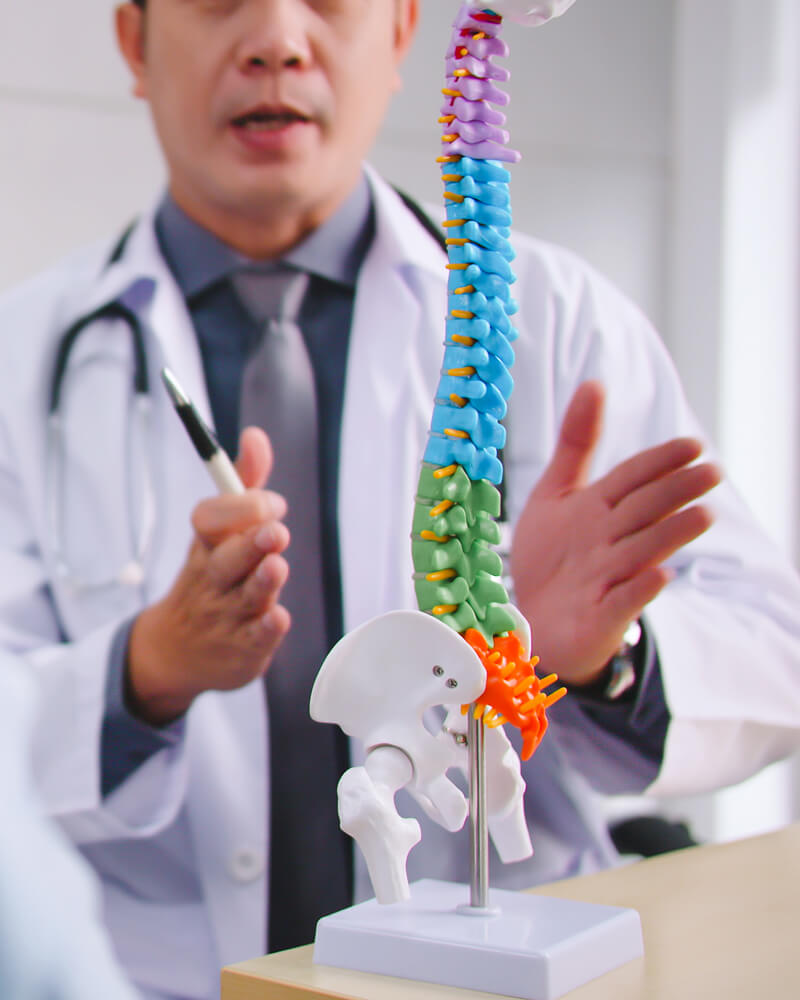- Find a Doctor
- Services & Specialties
-
-
Services & Specialties
-
-
-
-
- Find a Location
- News & Resources
-
-
News & Resources
- Latest News
- Learn More About Our Surgery Centers
- Why Proliance Surgeons?
- Meet Our Leadership
- Meet Our Board
- 24/7 Care Info
- Contact Us Today
- Pay My Bill
- Career Opportunities
- Mission, Vision, Values
- Phreesia FAQ
- Insurance Plans
- Medical Records
- Balance Billing Protection Act
- PELTO Health Partners
- Revenue Cycle Credit Resolution
- Proliance Surgeons Foundation
- Mental Health Resources
-
-
-
-
- Pricing
Spine: Orthopedic Conditions & Treatments
The spine supports the body and helps with walking, twisting, and moving. It consists of bones (vertebrae), discs (the cushions between the vertebrae), joints, and nerves. Many conditions, diseases, and types of injury can impact the spine along with a variety of treatments and surgery options depending on the nature of the condition.

Anatomy of the Spine
The spine connects different parts of the musculoskeletal system and helps with sitting, standing, walking, twisting, and bending. A healthy spine helps absorb shocks and protects the spine cord and nerves from injury. The spine is a complex system made up of many different parts:
- Vertebrae: the spine has 33 vertebral bones which support the body and protect the spinal canal. The spinal canal is a tunnel that holds the spinal cord and nerves to protect them from injury. Most of the vertebrae move, giving the body a greater range of motion, though the lowest ones are fused together and don’t move.
- Intervertebral discs: flat, round cushions that sit between the vertebrae and act as shock absorbers for the spine. These discs are under constant pressure and are soft and gel-like at the center.
- Facet joints: to allow the vertebrae to slide against each other, there are spinal joints that have cartilage and allow greater flexibility and stability, as well as letting the body twist and turn.
- Spinal cord and nerves: the spinal cord is a column of nerves that travel through the spinal canal, extending from the skull to the lower back. There are 31 pairs of nerves branching out through vertebral openings in the spinal canal to carry messages from the brain to the body.
- Soft tissues: there are many ligaments that help connect the vertebrae together as well as tendons that connect muscles to the vertebrae. Ligaments help to strengthen the parts of the spinal column.
Beyond the main parts of the spine, there are also 5 distinct spinal segments that consist of all 33 vertebrae:
- Cervical: this is the neck and top part of the spine which consists of 7 vertebrae and allows the neck to turn, tilt, and nod. When viewed from the side, the cervical spine has a slight bend backwards which is called lordosis.
- Thoracic: this is the middle of the back and includes 12 vertebrae to which the ribs are attached. When viewed from the side, the thoracic spine has a slight bend forward, which is called kyphosis.
- Lumbar: this is the lower back and includes 5 vertebrae that make up the lower part of the spine. The lumbar spine supports the upper parts and connects to the pelvis, bearing most of the body’s weight and the stress of lifting or carrying things. When viewed from the side the lumbar spine has a slight bend backwards which is called lordosis.
- Sacrum: a triangle-shaped bone that connects to the hips and is made up of 5 sacral vertebrae and doesn’t move.
- Coccyx: the tailbone is 4 fused vertebrae that make up the small bone at the bottom of the spine which is attached to the pelvic floor muscles and ligaments.
Spinal Conditions
Back, neck, arm, and leg pain are the primary symptoms of a spinal condition but there may also be weakness, numbness and tingling or even balance issues and problems with bladder or bowel function. Some of these conditions are the result of arthritis, injury, infection, or cancer. In general, pain and other symptoms result from abnormal compression of the nerves or spinal cord or from arthritic pain at the discs or the joints.
- Spinal cord injuries, such as paralysis, herniated discs, and fractures
- Spine tumors, cancerous and benign
- Spine infections
- Spinal defects, such as spina bifida
- Bone spurs, jagged edges on the vertebrae or joints that put excessive pressure on the spinal cord and nerves
- Back sprains and strains
- Spine arthritic conditions, such as ankylosing spondylitis
- Osteoporosis, a disease that weakens bones to the point they become susceptible to sudden fractures
- Problematic curvatures of the spine, like scoliosis
- Neuromuscular diseases, such as amyotrophic lateral sclerosis

Spinal Surgeries & Spine Treatments
Depending on the condition affecting the spine and/or vertebrae, there are many non-surgical and surgical treatment options.
Non-surgical options include:
- Physical therapy (PT) which may help strengthen the muscles around the spine, improve range of motion, and improve pain with stretching, exercises, and specialized techniques like ultrasound and nerve stimulation.
- Injections can be done in many locations including the epidural space, near specific nerves, in the sacroiliac joints or around the facet joints. Generally, injections are performed by specially trained radiology, anesthesia, or pain doctors. The goal of injections are to help treat pain and to also help figure out where pain is coming from.
- Bracing may be used to help decrease back pain from a broken vertebra, to help stabilize the back after surgery, or to help prevent the progression of scoliosis.
- Medications like oral steroids, non-steroidal anti-inflammatories, muscle relaxants, or nerve blocking medications are also commonly used.
- There are other options that patients may find helpful including acupuncture, chiropractic treatment, massage, and radiofrequency ablation (nerve burning).
Surgical options include:
- Spinal Decompression: taking pressure off nerves or the spinal cord where they are compressed. Spinal stenosis is the medical term for narrowing and pressure on the spinal cord or nerves. Spinal stenosis can lead to pain, numbness, and weakness. The surgeon will remove part of vertebrae and bone spurs to open the spinal channels and remove the pressure.
- Discectomy: removing a herniated disc (“slipped disc”) when that disc piece is pressing on the nerves. This is sometimes done with a medical microscope and is accompanied by removing a piece of a bone (the lamina) on top of the disc.
- Foraminotomy: enlarging the channel where the nerve that exits the spinal column travels. Thickened ligaments, bone spurs, enlarged joints, and disc material can all cause compression on this channel which is called the foramen.
- Spinal Fusion: using metal rods and screws to allow for two or more vertebra to heal together to prevent any painful motion at those levels. A spinal fusion may also use your own bone, cadaver bone, or special bone forming compounds to help the healing process. Sometimes, the disc between two vertebrae will be removed and a metal, plastic, or bone spacer is placed there to help open the nerve channels and to help with healing. This is called an interbody fusion.
- Vertebroplasty and Kyphoplasty: injecting cement into a broken vertebra to help strengthen it, improve alignment, and to alleviate pain after a spinal fracture.
- Artificial Disc Replacement: replacing a disc with a moving implant to both remove the pressure on a nerve and to allow the spine to maintain some of the motion. Disc replacement is done both in the cervical and lumbar spine but these procedures should only be performed on patients who meet very specific criteria.
- Sacroiliac (SI) joint fusion: putting implants across the sacroiliac joint when it has been proven to be the main source of pain to help it heal together and stop painful motion.


